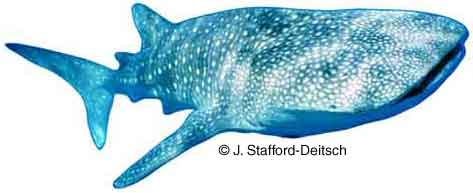
|
|
|
|
|
|
Shark Info (09-15-2000) |
Author |
|
Intro: |
Shark Info |
|
Main article: |
Whale Sharks: Central Theme of the AES Conference in La Paz, Mexico |
Shark Info |
Article 1: |
Shark Info |
|
Article 2: |
Dr. A. J. Godknecht |
|
Article 3: |
Dr. E. K. Ritter |
|
Fact Sheet: |
Dr. E. K. Ritter |
|
Whale Sharks: Central Theme of the AES Conference in La Paz, MexicoBy Shark Info Once a year scientists from around the world meet to discuss the newest results from shark and ray research. This year's Symposium of the American Elasmobranch Society (AES) took place from June 14 to 18 in La Paz, Baja California Sur, Mexico. Our Shark Info team was there. The Symposium focused on shark and ray fishing in Baja California and on whale sharks, but also touched upon other research areas, including the migration of the white shark (Carcharodon carcharias) in Australia and opinions on how shark accidents should be assessed and investigated. The following report concentrates primarily on whale shark activities. Shark Info will cover the other subjects in future issues.
Once again the Symposium showed that even though whale sharks (Rhincodon typus) are the largest and most well-known species of ocean sharks, many aspects regarding these animals still remain a mystery. Astonishingly, they belong to those species who can be kept in aquariums despite their size. The aquarium in Okinawa has kept whale sharks for about 20 years, three of their animals having lived longer than five years. Despite this enormous effort, many biological details are still unsolved. Accordingly, one of the central questions posed at the Symposium was whether or not they migrated. Individual observations stemming from the Sea of Cortez appear to show that the animals are very migratory by nature and that they swim thousands of kilometers each year. It is important to investigate such indications, especially since whale shark populations in Asia have recently suffered drastic losses due to the large demand for "tofu sharks" (whale sharks) in Taiwan. One of the major catch areas has been the region around the Philippines. Various nature protection organizations and local universities have now joined forces to find out via satellite trackings more about where these animals stay and their migration routes. Similar tracking attempts have previously been undertaken in South Africa and the Honduras. Such projects should help us improve the monitoring of whale sharks and in turn work out respective protective measures. In single regions in the Philippines, e.g. Donsol (southern Luzon), whale sharks have been protected since March 1998 and efforts are under way to replace illegal fishing with ecological touristic activities. Initial results of such actions have shown that local communities registered a clear economic upswing. In addition, application of this successful concept has not been limited to the Philippines. How large are whale shark populations?Another much debated and very interesting question was: How large are whale shark populations? Do the animals migrate primarily as single individuals or in groups? Based on information received from local fishermen, scientists researched regions in Belize (Central America), among other areas. Observations revealed that whale sharks apparently journeyed there in greater numbers at certain times of the year. Research showed that up to 25 whale sharks gather there at the same time when two species of bony fish deposit their eggs and sperm. Whale sharks live mainly off plankton (microscopic organisms), but in this instance proof was brought for the first time that they also seek out other food sources such as eggs layed by bony fish. Various whale sharks were marked during this event and then tracked during their subsequent migrations. Most of the animals returned to deeper waters where they appeared to associate with various bony fish species. Concluding this part of the Symposium on whale sharks was a documentary video which for the first time showed how an orca (Orcinus orca) hunted a whale shark. The film was impressive and certainly unique, abut the observers failed to film the underwater chase so that, unfortunately, we must continue to speculate on how the whale managed to approach the whale shark and bite him. Apart from humans and orcas, whale sharks have practically no enemies, accordingly, the development of their protective mechanisms are more limited. In the example seen, the whale shark always turned his back to the whale, but in the end unsuccessfully. May be published only by indicating the source: Shark Info / Shark Info |
|
|
|
|
|
|||||
